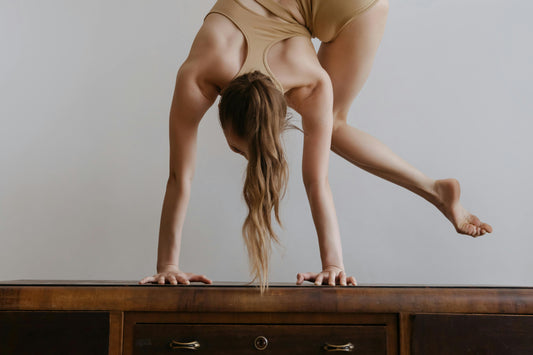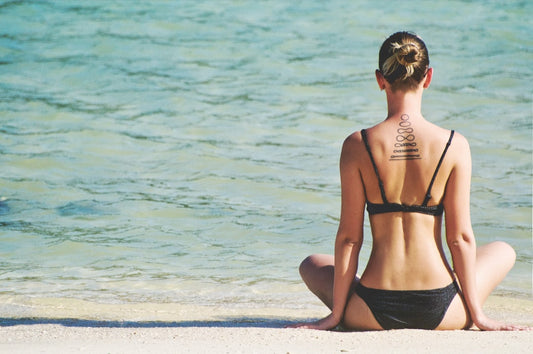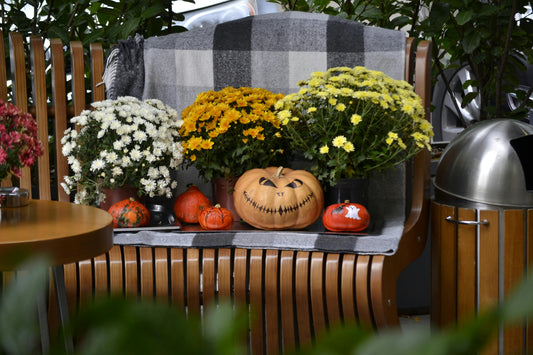How to adapt your yoga practice to live well in winter ?

You can feel the chill in the air ? Winter is coming ! But don’t panic, we have the solution to transform this cold and dark season into a true cocoon of well-being. Our secret weapon ? Yoga, of course !
Imagine: you, comfortably seated on your carpet, surrounded by soft light and a warm atmosphere. You are in a comforting posture, feeling the stress and tension dissipate with each breath. That’s the magic of yoga in winter !
The keys to winter-friendly yoga practice
| Aspect to consider |
Practical tips |
|
Yoga style |
Opt for yin yoga, hatha yoga and yoga nidra |
|
Recommended postures |
Deep stretches, ground postures, soft twists |
|
Useful accessories |
Blankets, cushions, blocks for comfort |
|
Integration into everyday life |
Create a warm space, plan regular sessions |
Why should you adapt your yoga practice in winter?
Winter is not a season like any other. It’s a time for slowing down, listening and observing yourself. Our natural energy comes down, pushing us to turn inward. Adapting your yoga practice during this period means respecting the need for gentleness and slowness. It is also an opportunity to recharge your batteries in harmony with nature’s cycles.
The benefits of yoga in winter
Yoga in winter is a breath of fresh air for the body and mind. It helps to strengthen the immune system, circulate vital energy, and maintain flexibility despite the cold. It’s also a great way to manage the stress and fatigue often associated with the holiday season.
How does the cold affect our yoga practice?
Cold tends to contract muscles and slow blood flow. Our joints may seem stiffer, and some postures become less accessible. It is therefore essential to slow down, take the time to warm up gently and do not hesitate to use accessories to support the postures.
What yoga postures to practice during the winter?
Start with sun salutations
Sun salutations are a dynamic sequence ideal to start your yoga session. They help boost blood circulation, gradually warm up the muscles and gently wake up the body. This sequence brings energy and vitality, perfect to start the day or to revitalize at any time.
The steps of a sun salutation :
- Pranamasana (Prayer posture): Standing with your hands together in front of your chest, take a moment to center yourself.
- Urdhva Hastasana (Posture of hands raised): Breathe in by raising your arms to the sky, stretch.
- Uttanasana (Bending forward standing): Exhale by leaning forward, hands to feet
- Ashwa Sanchalanasana (Horse Cleft): Breathe in by pushing back the right leg, knee to the ground, looking up at the sky.
- Phalakasana (Plank): Hold your breath by bringing the other leg back, body in line.
- Ashtanga Namaskara (Eight-body greeting): Exhale by resting knees, chest and chin on the floor.
- Bhujangasana (Cobra): Inhale by straightening the bust, low shoulders.
- Adho Mukha Svanasana (Dog upside down): Exhale by lifting the hips, form an inverted V.
- Back to Ashwa Sanchalanasana: Breathe in by bringing your right foot back into your hands.
- Uttanasana: Exhale by bringing the other foot forward, lean forward.
- Urdhva Hastasana: Breathe in while standing up, arms raised.
- Pranamasana: Exhale by bringing your hands in front of the chest.
Standing postures to strengthen and tone
After the sun salutations, integrate standing postures to strengthen your body and boost your vital energy.
- Utkatasana (The chair): This posture strengthens the thighs, buttocks and stimulates the digestive system. Standing with feet together or slightly apart, bend your knees as if you were sitting on an imaginary chair. Raise your arms to the sky and keep your back straight. Breathe deeply while maintaining posture.
- Vrikshasana (The tree): It improves balance and concentration. Standing, transfer weight to one leg, place the opposite foot on the ankle, calf or thigh (avoid knee). Join hands in front of chest or raise them above head. Fix a point in front of you to keep balance.
- Virabhadrasana II (Warrior II): This posture strengthens the legs and opens the thorax, thus facilitating breathing. Spread your feet, turn your right foot 90°, bend your right knee. Extend your arms horizontally, look towards your right hand. Hold the posture by breathing deeply.
- Trikonasana (the triangle): It stretches the back of the legs and the back, ideal against the tensions of the lower back. Standing, spread your legs widely. Turn right foot 90°, extend arms horizontally. Lean to the right, place your right hand on your ankle, tibia or knee, and your left arm toward the sky.
These postures energize the body while strengthening it, and promote a better circulation of energy.
The ground postures to relax
After warming and toning the body, it is beneficial to move to floor postures to relax and stretch deeply.
- Balasana (The Child’s Posture): It stretches the back and relaxes the nervous system. Kneel, sit on your heels, lean your chest forward to rest your forehead on the floor. Arms can be stretched out in front of or along the body. Breathe slowly and deeply.
- Eka Pada Rajakapotasana (The Pigeon): This posture deeply opens the hips and relieves the lower back. From the dog’s upside down position, bring the right knee to the right wrist, the left leg extending behind you. Keep your hips in line, lean forward if you wish.
- Paschimottanasana (The seated clamp): It stretches the back of the legs and soothes the mind. Sit, legs straight in front of you, lean forward from the hips, keeping your back straight. Reach for your feet or ankles, release the nape of the neck.
- Ardha Matsyendrasana (The seated torsion): It detoxifies the organs and brings an internal massage. Sitting, bend one leg, place the foot outside of the opposite knee. Turn the bust towards the bent knee, place the opposite elbow on the knee to intensify the twist.
These postures promote muscle relaxation, release tension and help to lower energy, preparing the body and mind for a deep relaxation.
End with a relaxation
The yoga session in winter would not be complete without a relaxation phase to integrate all the benefits of the practice.
- Savasana (The posture of the corpse): Lie comfortably on your back, arms along your body, palms towards the sky. Don’t hesitate to cover yourself with a blanket to stay warm. Close your eyes, relax each part of your body, and let yourself be carried away by your breath.
- Yoga Nidra: This guided meditation practice is perfect for winter. It allows for deep relaxation of the body and mind, helping to reduce stress and improve sleep quality.
Allow yourself 5 to 10 minutes or more for this final relaxation. It is a special time to recharge your batteries, release the accumulated tensions and connect with your inner being.
Accessories for a comfortable practice
In winter, comfort is essential. Feel free to use:
- Blankets to wrap you in during the postures of relaxation.
- A Yoga mat in organic cotton that takes care of you and your home.
- Yoga blocks and straps to support your body in the most demanding postures.
- Yoga pillows/bolsters to provide softness and support in sitting or lying postures
These accessories will allow you to settle comfortably and fully enjoy the benefits of your yoga practice.
Keep your motivation for yoga in winter
Staying motivated when the temperatures are dropping is not always easy. To stay on track, create a pleasant ritual around your practice, for example by preparing a hot chocolate after your session. Vary yoga styles to avoid monotony, and join online or studio yoga classes to share the energy of the group.
Create a warm space for your yoga practice
Your environment greatly influences your motivation. Create a dedicated yoga area with elements that inspire you to be calm and serene. A comfortable carpet, some plants, scented candles, and here is a space that invites you to settle down and refocus.
More than ever, winter is a season to listen. Adapting your yoga practice does not only mean changing the postures, but also being attentive to your needs. If you feel tired, prefer softer sessions. If on the contrary you need to warm up, do not hesitate to integrate more dynamic sequences.


